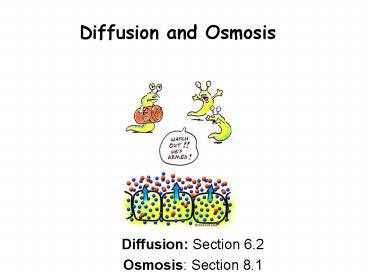Diffusion and Osmosis - PowerPoint PPT Presentation
Title:
Diffusion and Osmosis
Description:
Diffusion and Osmosis Diffusion: Section 6.2 ... Engulfs bacteria, food etc. Chapter 5 Active Transport Exocytosis Excretion of materials from a cell. – PowerPoint PPT presentation
Number of Views:166
Avg rating:3.0/5.0
Title: Diffusion and Osmosis
1
Diffusion and Osmosis
- Diffusion Section 6.2
- Osmosis Section 8.1
2
Biology 10/29/13
Mrs. Turgeon
- DO NOW
- Get out your cell lab worksheet
- In your notes Describe one difference between an
animal cell and a plant cell. - AGENDA
- Finish part F of cell lab as a group
- Take notes on diffusion and osmosis
- REMINDERS
- Science Club today after school, room 312!
- Science Fair judges still needed
3
Objective
- SWBAT explain how molecules are transported
across the cell membrane.
4
Diffusion
- The net movement of molecules from an area of
higher concentration to an area of lower
concentration.
5
Diffusion
- Diffusion results because of the random movement
of particles. - Three key factors concentration, temperature,
pressure affect the rate of diffusion. - Equilibrium is reached when there is an even
distribution of solute molecules
(water)
6
Osmosis
- The diffusion of water across a selectively
permeable membrane.
7
Osmosis
- In a cell, water always moves to reach an equal
concentration on both sides of the cell membrane.
8
Osmosis
- The direction of osmosis depends on relative
concentrations of dissolved particles on the two
sides of the membrane.
9
Direction of Osmosis
- Isotonic Solution
- concentration of dissolved particles outside and
inside the cell are equal. - there will be no net movement of water.
- water diffuses into and out of the cell at equal
rates.
10
Direction of Osmosis
- Hyptertonic Solution
- concentration of dissolved particles outside the
cell is higher than in the cytosol. - water will diffuse out of the cell.
11
Direction of Osmosis
- Hypotonic Solution
- concentration of dissolved particles outside the
cell is lower than in the cytosol. - water will diffuse in to the cell.
12
(No Transcript)
13
How Cells deal with Osmosis
Chapter 5
- To remain alive, cells must compensate for the
water that enters the cell in hypotonic
environments and leaves the cell in hypertonic
environments.
14
Passive Transport
- Movement of molecules across the cell membrane
- Does NOT require energy
- Examples diffusion and osmosis
15
Facilitated Diffusion
- Passive transport of materials across the cell
membrane using transport proteins. - Examples
- Carrier Proteins
- Ion Channels
16
Facilitated Diffusion
Chapter 5
17
Chapter 5
Active Transport
- Movement of particles across the cell membrane
against the concentration gradient - (lower concentration ? higher concentration)
- Requires ENERGY!!!
- Example
- Carrier proteins, endocytosis, exocytosis
18
Chapter 5
Active Transport
- Endocytosis
- Cells ingest external materials by folding around
them and forming a pouch. - Engulfs bacteria, food etc.
19
Chapter 5
Active Transport
- Exocytosis
- Excretion of materials from a cell.
- Expels wastes, hormones etc.































